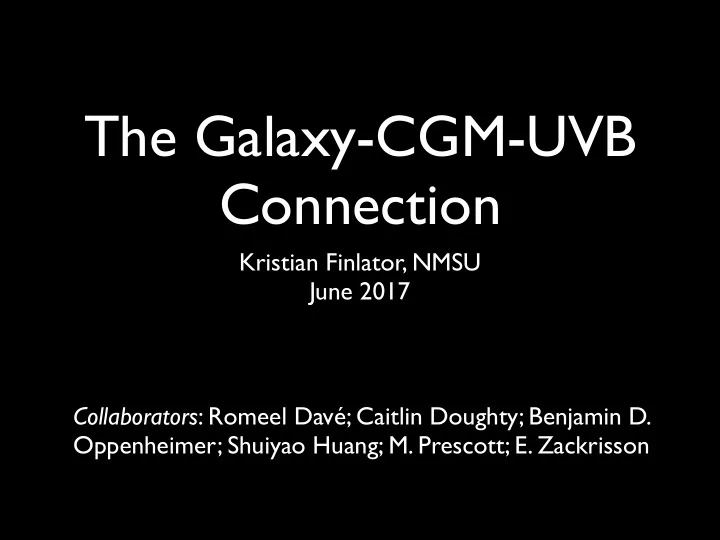

The Galaxy-CGM-UVB Connection Kristian Finlator, NMSU June 2017 Collaborators : Romeel Davé; Caitlin Doughty; Benjamin D. Oppenheimer; Shuiyao Huang; M. Prescott; E. Zackrisson
Modeling the CGM, the Galaxies, and the UVB Question 2 What is the z ≥ 6 CGM’s metallicity? What sort of UVB is in CGM? Question 3 How does one detect the host galaxies of the reionization-epoch CGM?
Method: Cosmological Simulation with a live UVB Hydrodynamics + Matter GADGET -3 (density-independent SPH; Hopkins+) 12 h -1 (= 17.74791851) cMpc simulation volume 2x512 3 or 2x256 3 particles ~100-200 pc hydro resolution Tests I won’t show: ✓ UV luminosity function at z ≥ 5 (KF+2016b) Star Formation Feedback 𝜃 (M * ) from Muratov+2015 “FIRE” zoom simulations ✓ SFR density versus Madau & Dickson 2014 ✓ CMB optical depth to Thomson scattering “Live” UVB : Evolved on-the-fly using moment-based RT. ✓ UVB amplitude at z = 5 • Opacities from H, HeI, HeII. • 24 energy bins (1-10 Ryd), 32 3 or 64 3 voxels. Simulated Metal Absorbers Custom ray-casting code uses local UVB and all relevant transitions to compute ionization state, optical depths.
50% Ionized Universe: Many Galaxies per HII Region � : show 12 h -1 Mpc galaxies’ positions 12 h -1 Mpc
Cut at M UV < -15: Few Galaxies Observable, even with JWST! � : gal’s w/ M UV < -15 12 h -1 Mpc There are 2. (Can you find them?) 12 h -1 Mpc
UVB is bright in ionized regions …and the spectral slope varies too!
UVB inhomogeneous at z=7 (x HI = 20%) CII: suppressed UVB CIV: enhanced UVB KF+2015
SiIV/CIV Observations at z~6 support a soft, inhomogeneous UVB KF+2016a (also Doughty+ in prep)
CIV host galaxies: example, z = 5.75 N CIV =1.13x10 13 cm -2 Z CGM = 10 -3 -10 -1 Z 0 J 𝞷 amplified 2-4x over volume-average Complex system with Δ v ~200 km s -1 Aligned CII: simpler velocity profile
Not one host galaxy per metal cloud x: position of absorber with N CIV =10 13 cm -2 420 pkpc slice depth = 50 km/s dots: all galaxies stars: M UV ≤ -17 box: 40 pkpc rad. ≈ 1 HST FOV 420 pkpc
Local UVB enhances CIV (Motivation: averaging over sightlines; cf. Mark Anderson’s talk)
Local UVB enhances CIV, but CIV still underproduced at z=5.75 (Motivation: averaging over sightlines; cf. Mark Anderson’s talk) similar results: Keating +2016, Bird+2016; Nelson+; Rahmati +2016 difference from KF +2015: different outflow scalings
Finding Hosts of Weak Absorbers at z=5: They’re Faint! •More than half of the hosts of systems with N~10 13 cm -2 are fainter than M UV = -15. •CIV hosts are much brighter than OI hosts. •Weak metal absorbers are complementary tracers of faint galaxy formation.
Takeaways: Q2 (CGM physical conditions) At z ≥ 6, the CGM has [Z/Z 0 ] = -1 to -3, with a small amount of primordial gas. The UVB amplitude is enhanced/suppressed around high/low-ionization absorbers. The effect grows stronger at z ≥ 6.
Takeaways: Q3 (absorber-galaxy relation) Search radii of ≥ 100 pkpc are required to detect hosts of weak CIV absorbers at z=5. Hosts of weak OI absorbers are even fainter. But: The probability of detecting an absorber’s host increases strongly with the absorber column.
Recommend
More recommend